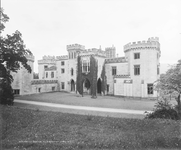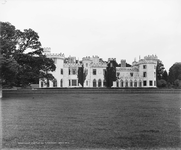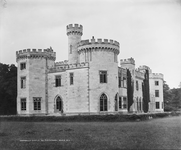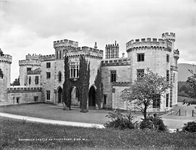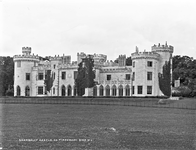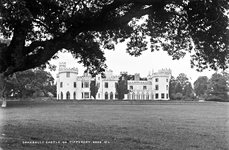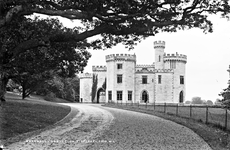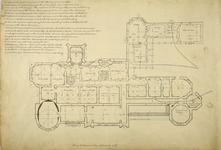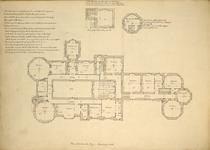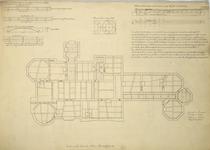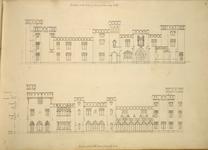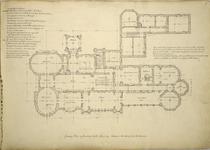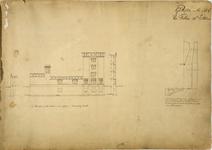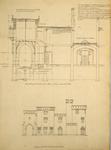Shanbally Castle: A Lost Treasure
A brief overview of the history of Shanbally Castle
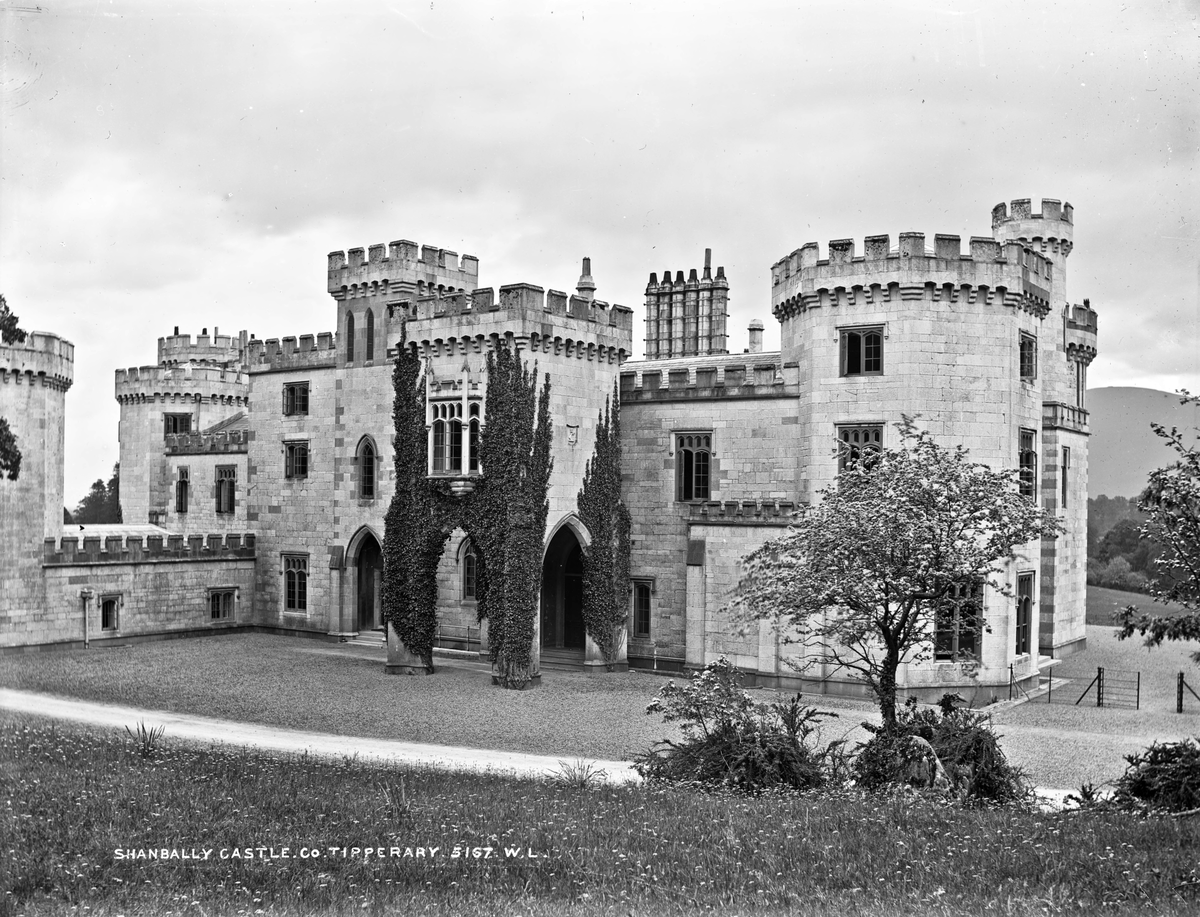 Shanbally Castle, circa 1865
Shanbally Castle, circa 1865
Table of Contents
Introduction
For those of you who are familiar with your history or architecture the name of John Nash will sound quite familiar. Nash is a famous British architect who was responsible for much of the design of Regency London. From 1810 onwards he was mainly employed by the then Prince Regent, who would later become King George IV, and worked on very few private projects in this time. His first task for the Prince was the development of Regent Street and the surrounding area. Some of his most famous work include the Royal Pavilion in Brighton and the development of Buckingham House in to Buckingham palace, the Royal Mews and the Marble Arch, which would later become the entrance to Hyde Park.
Anyway I’m talking about John Nash now as I’m at home for the Christmas period and was recently passing through my local town (Cahir, Co. Tipperary) which owes quite a bit of its heritage to a certain John Nash. He was responsible for one of the towns most visited attractions, the Swiss Cottage and several other buildings (Erasmus Smith School and St. Paul’s Church of Ireland) in the town. The Swiss Cottage is an ornamental cottage that was built for the Baron of Cahir in 1810. The cottage has a thatched roof and includes rooms full of fancy furniture and hand-painted wallpapers. The cottage was fully restored in 1989 and is now open to the public and is a major tourist attraction for the town along with the stunning medieval castle in the town centre. Nash was also responsible for the design of the school which I attended, which was originally the Erasmus Smith School when it was constructed and the nearby St. Paul’s church which is one of only two known churches by the Royal Architect in Ireland, and the only one with a nearly complete interior.
But these are all just the side story to the main act. Shanbally Castle. Or at least they would be if it wasn’t for some abysmal decision making. Shanbally Castle is situated just about 1km from my family home, which itself and the neighbouring houses were all once part of the Shanbally Estate and were constructed to provide accommodation for the staff of the Estate. But the castle is no more, and that is a huge loss, both for the local community and Ireland at large. As a building designed by the famous architect of the Prince Regent, one of only a handful of castles he built in Ireland, this was the largest of all those. Nash’s other famous castles were Ravensworth and Caerhays in England, with Shanbally being the last of his fine country homes to be built.
“Shanbally also had the distinction that it was built, not for the descendant of some Cromwellian carpetbagger, but for the scion of an old Irish family, Cornelius O’Callaghan.” 1
The Castle
Cornelius O’Callaghan engaged John Nash to design Shanbally Castle in 1810, which was situated between the Galtee Mountains and the Knockmealdown Mountains in South Tipperary. Construction was completed around 1819. The castle and estate was the property of the Earls of Ormonde (the Butlers: a powerful Norman ruling family) and whose principal residence was Kilkenny Castle.
The Estate comprised of 600 acres of farmland and 400 acres of woodland. The estate also included the estate manager’s house, and three houses which were known as ‘lodges’, and these were occupied by caretakers. There was Finn’s lodge; Carey’s lodge, and Norris’s lodge, and the whole estate was surrounded by a high stone wall, which was known by the local people as the ‘demesne wall’.
The castle location can be seen in the following historical maps from the OSI (Note: need to select historic map layer as the historic map is not the default).
The nearby Galtee Mountains also formed part of the Shanbally Estate and guests at the castle hunted deer and pheasant on the mountain. To facilitate this a hunting lodge (Mountain Lodge) was erected there in the 1830’s, and has for many years now been a youth hostel, having been acquired by An Óige for hikers. There was also a two-storey summerhouse down by the lake which was known as the tea-rooms.
Shanbally Castle with its 20 stately bedrooms, extensive drawing rooms, dining room, library, marble fireplaces and mahogany staircase was long and irregular in layout, made of a silver-grey ashlar and built in a Gothic Revival style. It had numerous machicolations, towers and battlements. The magnificent building can be seen in the following photos taken circa 1865.
In its heyday, Shanbally Castle was entered under a porte-cochère (carriage porch) into the main entrance hall. This was divided from the billiard room by a gothic arch. Directly beyond was a large top-lit gallery, at one end of which was an imperial staircase. Both of these rooms had fan-vaulted ceilings, while the ceilings in the other main rooms of the castle had excellent gothic plasterwork.
“To the right of the entrance hail was the dining room, while the garden front of the castle had, from left to right, the following; a dining room in the great round tower, lit by three lancet windows; a library, which occupied the central section of this front (also lit by three gothic windows); and, farther on, there was a conservatory of six bays with pointed windows.”
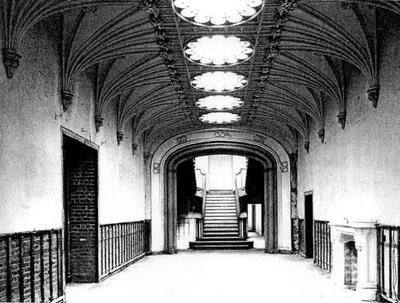
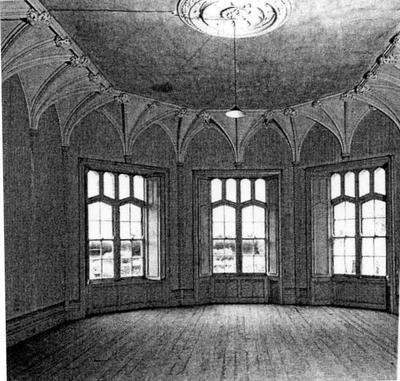
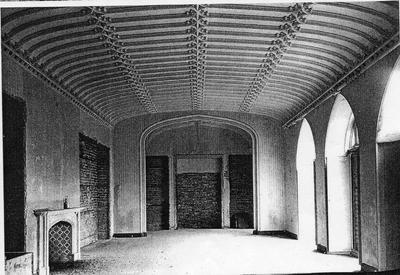
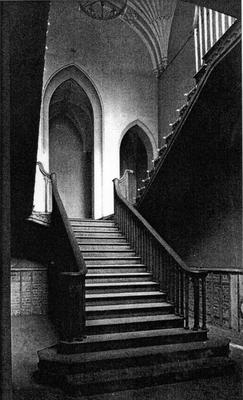
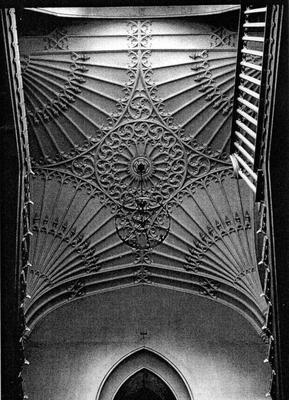
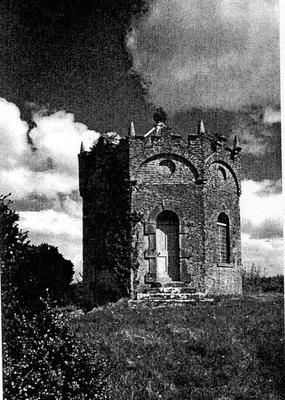
It has been noted that Shanbally bore a considerable resemblance to Nash and Repton’s joint venture, Luscombe Castle in Devon, all though Shanbally Castle was considerably larger. There is a stronger resembalnce to Caerhays Castle - You can judge for yourself here.
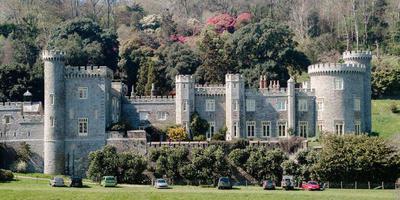
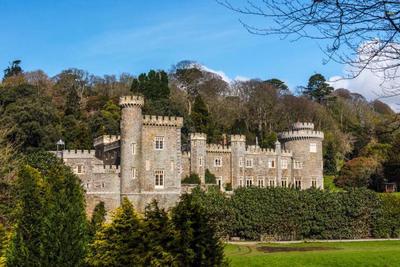
Shanbally castle was a magnificent house that was situated on landscaped gardens, with the whole lot over-looking a private lake which was often used activities such as boating. The woods belonging to the castle was used for rearing game, and visiting gentry to the castle enjoyed themselves in shooting parties there.
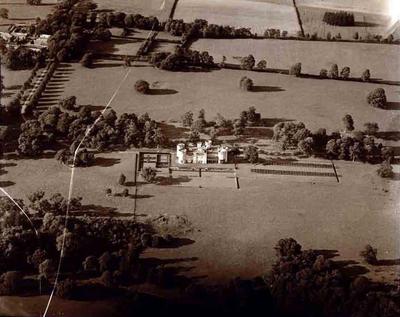
Even a reigning king and queen of England were entertained at Shanbally Castle. When, as king and queen, the royal couple of Edward VII and Alexandra visited Ireland in 1904 on a private trip to Kilkenny Castle (the seat of the Ormonde’s), Waterford and Lismore, they visited Shanbally Castle on their tour 2. This was likely due to the Marquess of Ormonde’s connection to the British royal family and their very powerful political position in Ireland for hundreds of years; the Ormonde’s attended the coronation of King George V and Queen Mary in 1911 3.
The Estate
A major part of the staff for the castle and estate hailed from nearby Glencallaghan and Clogheen, a house generally going with the job. Between the running of the estate farms, gardens, stables and the main house itself (along with maintenance for other estate properties) there were many locals people employed. I can’t give exact numbers but I have come across a list of about 25 people who were employed by the estate.
Accommodation for the staff consisted of 11 houses in Glencallaghan, 2 more located in Carrickmore, another 8 adjacent to Clogheen and a large number of houses in Clogheen. There was also a head gardener’s house, a shepherd’s house and a gamekeeper’s house.
The Estate was completely self-sufficient. Water for the castle and estate properties was pumped from two dams where DC electricity was also generated. Large flocks of sheep grazed on the mountains and these were cared for by the estate’s shepherds. Wool from these flocks was processed and woven into tweed for the family’s riding habits at nearby Ardfinnan Woollen Mills.
To the side of the castle on a slight rise of ground there stood a round, stone building called the Observatory. Also, on the grounds, there was a dogs’ and horses’ cemetery, complete with memorial headstones.
Many fine hunters were bred at Shanbally, including Cottage, ancestor of the famous ‘Cottage’ line of race horses, the most well-known of which was Sheila’s Cottage, winner of the Grand National in the 1940’s. Also, Cottage Rake, which won the King George VI chase in 1948 at Kempton. Cottage Rake won the Cheltenham Gold Cup in 1948, 1949 and 1950. This horse was trained by Vincent O’Brien at Ballydoyle.
With the passing of years the estate experienced difficult times and was eventually acquired by the Land Commission. All workers were given their houses to purchase for very little money, and some of these houses are still occupied by their descendants.
Family History
The following information about the family that built and lived in Shanbally Castle can be found in “The Lost Houses of Ireland: A Chronicle of the Great Houses and the Families who Lived There”1. The O’ Callaghan’s held the lands at Shanbally (Seanbhaile or ‘the old town’) for many generations. Thomas O’Callaghan of Shanbally married Sarah, the daughter of John Davis and his wife, the Honourable Ann Caulfield, daughter of the 2nd Viscount Caulfield. Thomas and Sarah’s son, Cornelius O’Callaghan was the member for Fethard in four parliaments in Dublin from 1761. In 1785, he was raised to the peerage as Baron Lismore of Shanbally. He married Frances Ponsonby, daughter of the Right Honourable John Ponsonby, who was Speaker of the Irish House of Commons in Grattan’s parliament, and died in 1797.
Their heir was Cornelius O’Callaghan, and Baron Lismore, who was raised to a viscountcy in 1806.
In 1807, Cornelius made an unsuccessful attempt to be elected as a Representative Peer of Ireland. He eventually got to parliament in 1838, when he was created Baron Lismore of Shanbally Castle in the peerage of the United Kingdom — one of Queen Victoria’s coronation peerages. Cornelius was also Lord Lieutenant of County Tipperary but scandal followed in 1826 when he divorced his wife Lady Eleanor Butler, the daughter of the Earl of Ormond and Ossory. Cornelius died at Shanbally Castle, the house he had commissioned.
His son, George Ponsonby O’Callaghan, 2nd Viscount Lismore, married Mary Norbury in 1839. He was Sheriff of County Tipperary in 1853 and Lord Lieutenant of the county between 1857 and 1885. His only son, the Honourable George Cornelius O’Callaghan, married Rosina, the widow of Edward Follett, at Umballa in India in 1874, but died childless at only 39. The 2nd Viscount was a Liberal until 1886 in which year, and in opposition to Gladstone’s attempts to introduce Home Rule for Ireland, he left the party, but he remained a Unionist. The Government offered him the Order of Saint Patrick in 1864 but he declined the honour and the peerages died with him in 1898 as both his sons pre-deceased him. His will was proved at £20,000.
His lordship was a victim of the Land War that took place during the 1880s, and he had a lot of land to be worried about. In 1883, his estates comprised 34,945 acres in County Tipperary, together with Shanbally Castle (1000 acres were all that was left in 1954 to be sold to the Land Commission), 6067 acres in County Cork and 1194 acres in County Limerick — making a total of 42,206 acres with an annual rent roll of £16,354.
After the last of the O’ Callaghan male heirs had deceased the castle then passed through the female line. It escaped the phase of house burnings that took place during the War of Independence, although the IRA did use it in 1921 as a training centre. When peace returned, two daughters of the 3rd Marquess of Ormonde, Lady Constance Butler and her sister, Lady Beatrice Pole-Carew, occupied the castle almost until the time of its destruction. Lady Constance continued to live in a wing of Shanbally until her death 1949, well after World War II. After the death of Lady Beatrice Pole-Carew in 1952, there was a five-day sale of the contents of the house.
A terrible decision
As time passed by the influence and wealth of the family declined and in 1954, Major Pole-Carew sold the estate to the Land Commission, which acquired 750 acres of arable land and 250 acres of woodland, as well as Shanbally Castle. For a short period it appeared that a buyer could be found for the castle and despite the attempts of a religious community and of Edward Sackville, 5th Lord Sackville of Knole to buy it. He agreed to buy the castle, together with 163 acres (0.66 km2), but pulled out of the transaction when the Irish Land Commission refused to stop cutting trees in the land he intended to buy. However, by 1957 it had been decided that Nash’s fine house should be levelled to the ground. At this point the castle was still in good condition, having been lived in up until quite close to the sale.
“Not only was the building of the first importance in the history of Irish domestic architecture but it was also in good and complete condition before it fell afoul of the crass ignorance and prejudice of the bureaucrats who decided to destroy it.”
First the civil servants gave instructions to remove the roof and the fitments. Then, in a wicked act of destruction the battlements were hacked down. This drew a protest from Professor Denis Gwynn, Chairman of the Cork Advisory Group of the Arts Council, to the Minister of Lands, Erskine Childers.
In that year, Professor Denis Gwynn, wrote an article in the Cork Examiner in which he pleaded with the authorities to reverse their decision:
`Shanbally Castle has been well known for years as one of the most graceful and original examples in Ireland of late Georgian architecture, Its formal gardens, which have run wild, could easily be brought back to order'
Describing the order to demolish the castle as an ‘act of vandalism’, Professor Gwynn called for an inquiry into the circumstances of the decision.
`There is no sense whatever in squandering public money on the destruction of a beautiful house which is well known to students of Nash’s domestic architecture’.
He received a reply stating that the Minister would be unavailable until mid-October, but would give the matter his fullest attention when he returned to work. But Professor Gwynn’s article was already too late. Despite some local opposition and widespread critical comment, the roof was removed and some of its impressive cut stones were being removed by hand and broken into smaller pieces for use in road building.
The demolition had started in September. The beautiful lawn trees at Shanbally were cut down and ‘rapidly carted away’. The Land Commission had sold the castle to a Limerick firm who razed it to the ground in order to salvage materials from the ruins and these were sold at public auction by a Limerick auctioneer. The ‘philistines’ who did this were merely symptomatic of the general attitude of the population at the time. The Land Commission issued the following notice: ‘The beautiful cut stone of the Castle will no doubt be put to practical use’.
The Government Information Bureau, in an attempt to defend the vandalism, issued the following statement, which although suited their narrative, should be considered a blatant lie:
‘Apart from periods of military occupation the castle has remained wholly unoccupied for 40 years.’
This attempt at deception was shown up for what it was when letters arrived at the newspapers from people who had bought items at the sale of the castle’s contents less than 20 years before. Indeed, a part of it had been lived in until a few years before its destruction. Undaunted by the truth, the government decided to press ahead with the demolition and the breaking up of the cut stone for the ‘practical use’ of surfacing roads.
Finally, in March 1960, explosives had to be used to demolish what remained of the castle, as it had been so well been built. According to a report in the local newspaper “The Nationalist”, on March 21st 1960:
`A big bang yesterday ended Shanbally Castle, where large quantities of gelignite and cortex shattered the building'.
Demolition experts bored no fewer than 1400 holes into the walls about 18 inches from the ground in order to level this once great building.
When the government apologists wrote that that the castle was in a dangerous state, Professor Gwynn: replied that
‘Shanbally Castle would not even have been a ruin if the Government had not authorised the removal of its roof and interior fittings.’
He went on about this wanton destruction
‘the slate and finely cut stone and the beautiful ornamented ceilings are already littering the ground,’
and reminded his readers that it could have been restored for a fraction of the cost of its destruction.
The Cork Examiner commented, in 1957 that:
‘Unless the present trends of the Department of Lands are stayed, there will be nothing in fifty years left to link the age of the Norman castle tower as a habitation, and the latest concrete semi-detached council house.’
All of this has gone, a victim of an ignorant mentality. A two-storey summerhouse down by the lake is all that remains of a house and a demesne which, if the government had allowed it to survive, would today be one of the treasures of Ireland’s heritage.
Photo Gallery
References
-
Randall MacDonnell, “The Lost Houses Of Ireland: A Chronicle of the Great Houses and the Families Who Lived There”, 2002. Weidenfeld & Nicolson, ISBN: 029784301X. ↩︎
-
Hunt, T. (2017). The Little Book of Waterford. Argentina: History Press. https://www.google.co.uk/books/edition/The_Little_Book_of_Waterford/U5ALDgAAQBAJ?hl=en&gbpv=1&dq=king+edward+and+alexandra+%22lismore%22&pg=PT56&printsec=frontcover ↩︎
-
The Peeresses at the Coronation. Patea Mail, Volume XXXIV, 21 Aug 1911. https://paperspast.natlib.govt.nz/newspapers/PATM19110821.2.2?query=Pole ↩︎
